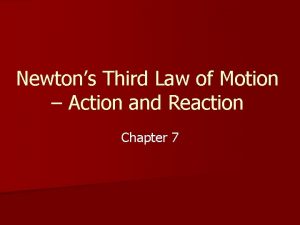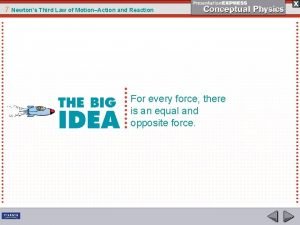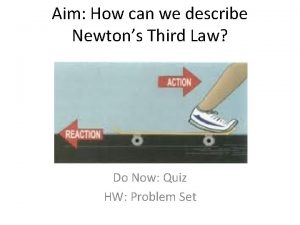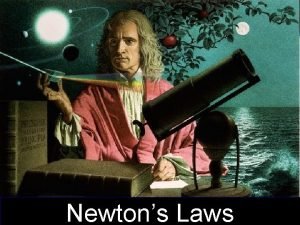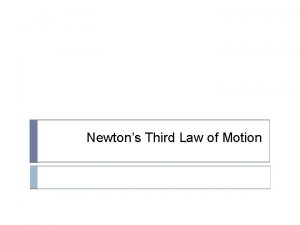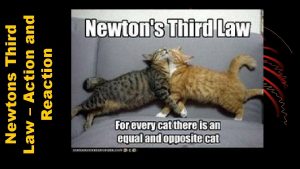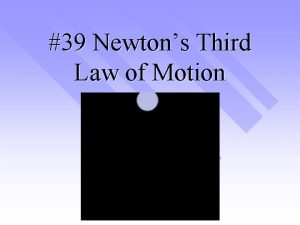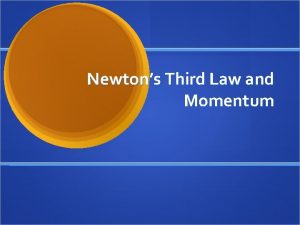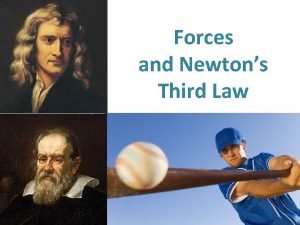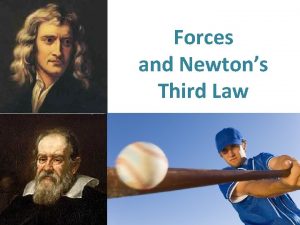Newtons Third Law of Motion Action and Reaction












- Slides: 12

Newton’s Third Law of Motion: Action and Reaction Chapter 6

Forces and Interactions A force is a push or pull Interaction – a mutual action between objects where each object exerts an equal and opposite force on the other Interacting things exert forces on each other

Newton’s Third Law Newton’s third law states: Whenever one object exerts a force on a second object, the second object exerts an equal and opposite force on the first object. One force is called the action force and the other is called the reaction force (it doesn’t matter which we call action and which we call reaction) Newton’s 3 rd law can also be stated as “To every action there is an equal and opposite reaction. ” In every interaction, the forces always occur in pairs When you walk, you are interacting with the ground; you push against the ground, and the ground simultaneously pushes against you

Identifying Action and Reaction Sometimes the identity of the pair of action and reaction forces in an interaction is not immediately obvious First, identify the interaction (one object, A, interacts with another object, B) The action and reaction forces can be stated in the form: Action: Object A exerts a force on object B Reaction: Object B exerts a force on object A

Identifying Action and Reaction

Action and Reaction on Different Masses The forces are equal in strength and opposite in direction Remember that Newton’s 2 nd law states that acceleration is proportional to net force, and inversely proportional to the mass If we have different masses interacting, the accelerations on each will be different If you consider a cannon and a cannonball; the cannon and cannonball exert equal and opposite forces on each other, but the cannonball moves much more than the cannon Because of Newton’s 2 nd law, the mass of the cannon stops it from accelerating as much as the cannonball a = Fnet/m

Cannons F = M(cannon) a(cannon) F = m(ball) A(ball)

Do Action and Reaction Forces Cancel? If action and reaction forces are internal to a system, they cancel each other and produce no acceleration of the system Action and reaction forces do not cancel each other when either is external to the system that is being considered

Do Action and Reaction Forces Cancel? An apple pulls an orange and the orange accelerates. The orange pulls back on the apple, but this affects the apple and not the orange. Both A and C act on B. They cancel each other so B does not accelerate.

The Horse-Cart Problem Force Horse pulls Wagon Horse pushes Ground Friction By On Direction Affects the Motion of Comments horse wagon right wagon horse left horse ground left ground horse right horse ground wagon left wagon ground right ground Action/Reaction Pair

Action Equals Reaction You can not hit anything harder than it can hit you back If the object is not able to exert a reaction force equal to your action force, then you cannot produce an action force that large

Assignment Read Chapter 6 (pg. 74 -82) Do Ch. 6 Assessment #19 -39 (pg. 84 -85) Do Appendix F #1 -6 (pg. 667 -668)
 According to the third law of motion action and reaction
According to the third law of motion action and reaction Law of motion 3rd
Law of motion 3rd Third
Third Newtons third law of motion
Newtons third law of motion Newton's 3 laws of motion
Newton's 3 laws of motion Newton's first law and second law and third law
Newton's first law and second law and third law Newton's first law and second law and third law
Newton's first law and second law and third law Describe newtons third law
Describe newtons third law Third law of thermodynamics derivation
Third law of thermodynamics derivation Newton's law
Newton's law Newton's law of motion
Newton's law of motion Newtons 3 rd law of motion
Newtons 3 rd law of motion Newtons 3 rd law of motion
Newtons 3 rd law of motion
